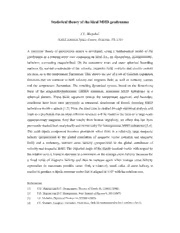
NASA Technical Reports Server (NTRS) 20120003215: Statistical Theory of the Ideal MHD Geodynamo PDF
Preview NASA Technical Reports Server (NTRS) 20120003215: Statistical Theory of the Ideal MHD Geodynamo
Statistical theory of the ideal MHD geodynamo J.V. Shebalin1 1NASA Johnson Space Centre, Houston, TX, USA A statistical theory of geodynamo action is developed, using a mathematical model of the geodynamo as a rotating outer core containing an ideal (i.e., no dissipation), incompressible, turbulent, convecting magnetofluid. On the concentric inner and outer spherical bounding surfaces the normal components of the velocity, magnetic field, vorticity and electric current are zero, as is the temperature fluctuation. This allows the use of a set of Galerkin expansion functions that are common to both velocity and magnetic field, as well as vorticity, current and the temperature fluctuation. The resulting dynamical system, based on the Boussinesq form of the magnetohydrodynamic (MHD) equations, represents MHD turbulence in a spherical domain. These basic equations (minus the temperature equation) and boundary conditions have been used previously in numerical simulations of forced, decaying MHD turbulence inside a sphere [1,2]. Here, the ideal case is studied through statistical analysis and leads to a prediction that an ideal coherent structure will be found in the form of a large-scale quasistationary magnetic field that results from broken ergodicity, an effect that has been previously studied both analytically and numerically for homogeneous MHD turbulence [3,4]. The axial dipole component becomes prominent when there is a relatively large magnetic helicity (proportional to the global correlation of magnetic vector potential and magnetic field) and a stationary, nonzero cross helicity (proportional to the global correlation of velocity and magnetic field). The expected angle of the dipole moment vector with respect to the rotation axis is found to decrease to a minimum as the average cross helicity increases for a fixed value of magnetic helicity and then to increase again when average cross helicity approaches its maximum possible value. Only a relatively small value of cross helicity is needed to produce a dipole moment vector that is aligned at ≈10° with the rotation axis. References [1] P.D. Mininni and D.C. Montgomery, Physics of Fluids 18, 116602 (2006). [2] P.D. Mininni and D.C. Montgomery, New Journal of Physics 9, 303 (2007). [3] J.V. Shebalin, Physics of Plasmas 16, 072301 (2009). [4] J.V. Shebalin, Geophys. Astrophys. Fluid Dyn., DOI:10.1080/03091929.2011.589385, (2011).
